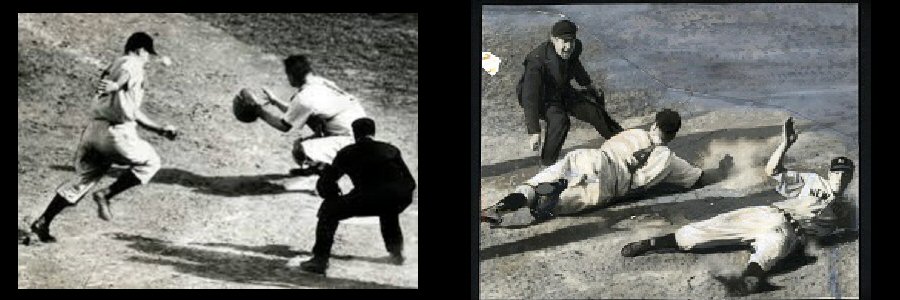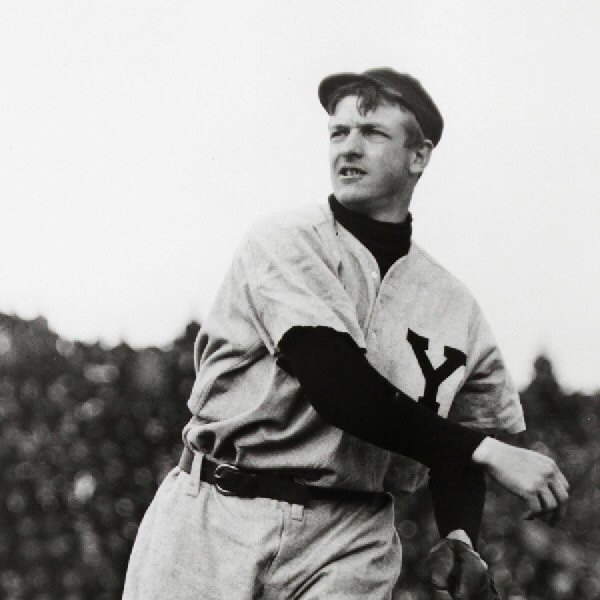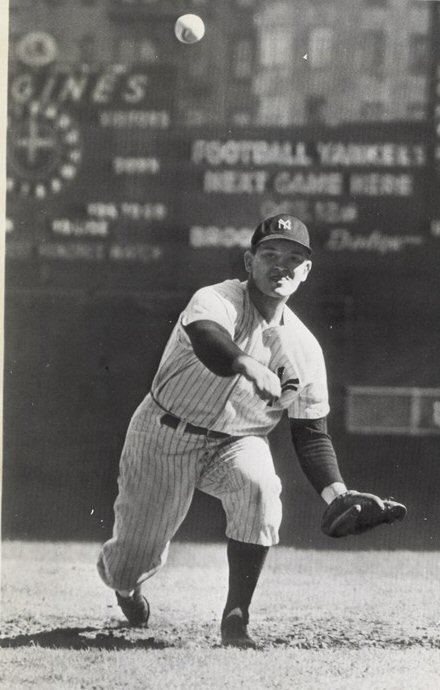, White Sox (2-0, 0.60) - The first cross-town series, and to this day the only one that matched the two Chicago teams. The Cubs had won 116 games and lost just 36, the win total and the .763 winning percentage have never been surpassed. But in baseball, you don't know nothing. Fielder Jones' Hitless Wonders shocked everyone, winning in six games. Neither team did much hitting - the White Sox batted .198 for the series, the Cubs hit .196 - neither team hit a homer. Ed Reulbach of the Cubs pitched a one-hitter to win the second game. Hey, it was 1906. Ed Walsh of the White Sox pitched a shutout with 12 Ks in the third game, and he somehow survived
errors behind him to win the fifth game.
, Cubs (2-0, 0.98) - The Cubs and Tigers staged a rematch and the Tigers managed to win a game this time. Overall beat Bill Donovan 6-1 in the second game and pitched a shutout with 10 Ks to beat him again in the finale. After these back-to-back titles, the Cubs would of course have to wait
before winning another.
1910 -
Jack Coombs, A's (3-0, 3.33) - The Cubs were back, but the AL had produced its own juggernaut in Connie Mack's first great Philadelphia team. It was led by two brilliant young infielders: 24 year old third baseman Frank Baker and 23 year old second baseman Eddie Collins. Both players would eventually be regarded as among the best to ever play their positions. The A's dismissed the Cubs in five. The great play of Baker (.409/.458/.636) and Collins (.429/.478/.619) notwithstanding, the star of the series had to be A's pitcher Jack Coombs. He provided three complete game victories in six days - on Tuesday, Thursday, and Sunday - and beat the great Mordecai Brown twice.
1911 -
Frank Baker, A's (.375/.400/.708, 2 HR 5 RBI) - The A's were back and won their second straight title, this one over John McGraw's Giants. Baker had led the AL in homers during the season (he hit 11 of them) but this World Series was where he earned his nickname. After Mathewson had pitched the Giants to victory in the opener, Baker hit a go-ahead homer in the second game. In the next game, with Mathewson two outs away from a shutout, Baker homered to tie the game in the ninth. The A's won the game in extras, the series in six and Frank Baker has been Home Run Baker from that day to this. Chief Bender (2-1, 1.04) had a lot to do with the Philly victory as well.
1912 -
Joe Wood, (3-1, 4.50) - The fabled 1912 World Series was a legend from the start, a saga retold in
an epic Box piece. It went to eight games (one was tied) - the finale was one of the classic contests in the game's history. Our MVP came
this close to being the goat. Wood pitched a complete game victory with 11 Ks in the second game, and he'd beaten the Giants again in the fourth game. But he got hammered for six first inning runs as the Sox tried to close out the Giants in the seventh game; and in the deciding game, Wood came out of the pen in the eighth inning with the score tied and surrendered the go-ahead run in the tenth. His team came back to bail him out. Christy Mathewson's series ERA was 0.94 and he went 0-2.
1913 - Frank Baker, A's (.450/.450/.600, 1 HR 7 RBI) - The A's were back to meet the Giants in a rematch of the 1911 series, and they needed just five games to win their third title in four years, with only Christy Mathewson's 10 inning shutout in the second game breaking their progress. Chief Bender beat the Giants twice, but both games were really won by the Philadelphia bats, Baker and Collins in particular. Baker got it all started in the first game with an RBI single in the fourth to tie the game; he hit a two run HR a couple of innings later to put the A's ahead. He started their scoring again in the third game and again in the fifth and final game. The next time these two teams met in the Series, they'd both have moved to the California Bay area and an earthquake would disrupt the proceedings.
1914 - Hank Gowdy, Braves (.545/.688/1.273) - The A's were back yet again, to take on a surprising opponent - the Boston Braves On the 4th of July, the Braves were dead last with a 26-40 record. But these were the Miracle Braves, and they went 58-19 the rest of the way to leave the rest of the NL in their dust. In the series, they swept the mighty A's, completely shutting down the Philly bats (.172/.248/.242) and allowing just 6 runs in the four games. Gowdy had three hits and a walk in the opening victory and in the third game his tenth-inning homer started a game-saving rally and his twelfth inning leadoff double would eventually score the winning run. Boston's 26 game winner Dick Rudolph beat Bender 7-1 in the opener and Shawkey 3-1 in the clincher.
1915 - Rube Foster, Red Sox (2-0, 2.00) - Philadelphia was back in the Series but this time it was the Phillies making their first ever appearance. Connie Mack had sold off all his stars and the A's had collapsed, freeing up the AL for Boston to take charge. Which they did, and after losing the opener to Pete Alexander they beat the Phils four times in succession. They got a pair of complete game victories from Foster, who also went 4-8 at the plate and drove in the winning run in Boston's 2-1 victory in the second game.
1916 - Ernie Shore, Red Sox (2-0, 1.53) - The Sox were back, this time against Brooklyn, and once more they cruised to a win in five games. Shore needed relief help from Carl Mays in the opener, as the Sox very nearly blew a 6-1 lead in the ninth. He was much better in the finale, pitching a three hitter in the 4-1 Boston win. Boston's 21 year old LH Babe Ruth made his first series start in the second game, and after allowing a first inning run, blanked Brooklyn the rest of the way. It took 14 innings before Boston finally managed the 2-1 win, meaning that Ruth had thrown what was, and what remains, the longest complete game in World Series history. I think that record will stand a little longer.
1917 - Red Faber, White Sox (3-1, 2.33) - The White Sox took over first place in May and never looked back, pulling far away from the pack down the stretch. In the Series, Eddie Collins led the Chicago attack with 9 hits, ably supported by Joe
Jackson and Buck Weaver. But the hitting star of the Series was Giants
right fielder Dave Robertson, who had led the NL in HRs during the season and would hit
.500/.522/.636 in the Series. Yet Robertson didn't start the fifth game.
With Sox southpaw Reb Russell on the mound, the starting right fielder
for the Giants was the legendary Jim Thorpe, one of the greatest
multi-sport athletes who ever walked the earth. But the Giants drove
Russell from the mound almost instantly, and with Cicotte on in relief,
Robertson pinch hit for Thorpe in the top of the first. And that was as
close as Jim Thorpe would ever come to appearing in a World Series game.
He was in the starting lineup, and he never got onto the field. Go figure. Eddie Cicotte was the Sox ace during the season but Red Faber stepped up against McGraw's Giants in the Series. Cicotte and Faber pitched complete game victories in the first two games but the Giants evened the series behind shutouts from Benton and Schupp. Faber came out of the pen and got the win as the White Sox rallied to take the fifth game, and he tossed a complete game in the finale for his third series win. The scoring started in the final game when Happy Felsch hit a comebacker to the mound, with Eddie Collins on third. Collins had broken for home, and when pitcher Rube Benton threw to the plate, they had Collins in a rundown. Catcher Bill Rariden chased Collins back towards third and then threw to third baseman Heinie Zimmerman. Collins reversed his field, and dashed past Rariden towards home plate, with Zimmerman behind him, the ball in his hand, in desperate pursuit. Because no one was covering home. Pitcher Benton and first baseman Holving were just standing around, watching the play. Collins slid across the plate to score the game's first run, as the pursuing Zimmerman vaulted over top of him. (Zimmerman was notably corrupt, even by the standards of the day, but John McGraw never blamed him for the 1917 Series. But McGraw would testify against Zimmerman and Hal Chase in hearings that led to both players being indicted on bribery charges. They beat the rap but they never played in the majors again.)
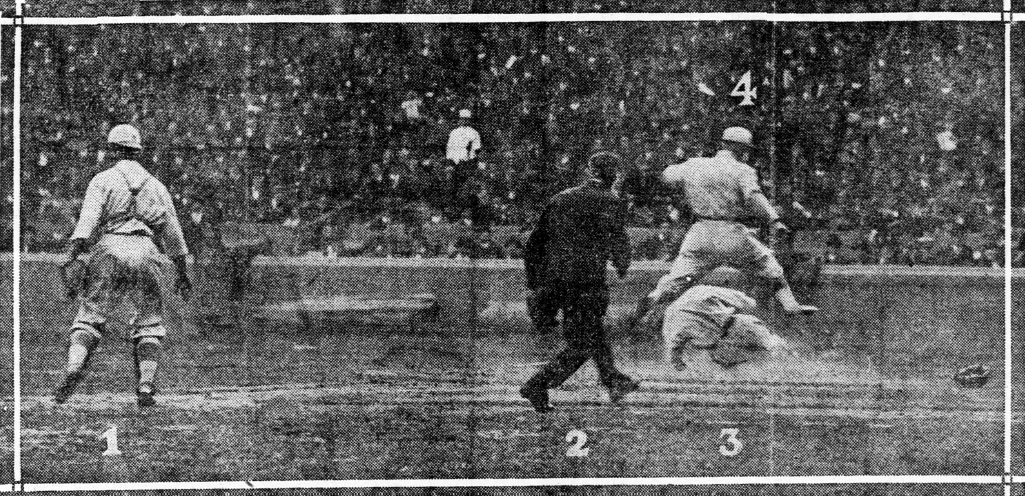
1918 - Babe Ruth, Red Sox (2-0, 1.06) - It was a weird season, shortened by the war - they played the World Series at the beginning of September. The Red Sox were back, and they beat the Cubs in six games. Carl Mays of the Red Sox won the third game and the finale with a pair of complete games - Ruth won the other two. Ruth did need some ninth inning relief help in the fourth game. But it was his own two-run triple that broke up a scoreless tie in the fourth inning. And with his shutout in the opener and his seven scoreless innings to begin the fourth game, he extended his own mark for consecutive scoreless innings in a World Series to 29.2 IP. Ruth would always claim he was prouder of that record than any of the ones he set with his bat, and why not? This record stood for 43 years, which is longer than either his single season or his career home run records (34 and 39 years respectively.)
1919 - Arnold Rothstein. (If you want a ballplayer... oh Greasy Neale of the Reds is as good a choice as any. It's just that Joe Jackson and Buck Weaver outhit him. Maybe Hod Eller?)
1920 -
Stan Coveleski, Indians (3-0, 0.67) - One of the wildest, and most significant, seasons in major league history -
I've written about it at my usual fulsome length - ended up with Cleveland meeting Brooklyn in the Series. Which was not without incident - it featured the first Series home run hit by a pitcher, the first Series grand slam hit by anybody, and what is still the only triple play - and an unassisted one, to boot - in Series history. But when a starting pitcher gives you three complete game victories, including a shutout in the finale, not much else matters.
1921 -
Irish Meusel, Giants (.345/.387/.586, 1 HR 7 RBI) - This was the third and final year of the experiment with a best of nine Series, and Waite Hoyt of the losing Yankees pulled off a feat accomplished just one other time in Series history. Hoyt pitched three complete games with 0.00 ERA, just as Mathewson had done in 1905. Unfortunately for Hoyt, he allowed a pair of
unearned runs, one of which was the only run scored in the series finale. Meusel was as productive as any of the Giants hitters and his timing was impeccable - his big hits came in the midst of all the Giants' crucial scoring outbursts.
1922 -
Frankie Frisch, Giants (.471/.500/.529) - The Giants swept the Yankees (one game was a tie) in a rematch, and Babe Ruth went 2-17, just to prove he was human. Irish Meusel drove in another 7 runs for the Giants but was actually outhit by kid brother Bob of the Yankees. Frisch singled and scored the winning run as the Giants came from behind to win the opener; he drove in the first run of their shutout victory in the third game; he doubled and scored the tying run as the Giants came from behind again to win the finale.
1923 -
Babe Ruth, Yankees (.368/.556/1.000, 3 HR, 8 RBI) - The two New York teams matched up for the third year in a row, and Heywood Broun of the
New York World wrote one of the
most famous ledes in sportswriting history after the second game. "The Ruth is mighty and shall prevail." The Babe had just hit a pair of homers in the Yankees second game victory. It's such a wonderful post-game story that I simply had to provide a link. Anyway, the Ruth was mighty indeed. It took six games, but he did prevail.
1924 -
Tom Zachary, Senators (2-0, 2.04) - The Giants were back for the fourth year in a row but the Washington Senators had never made it to the World Series before. The two teams provided one of the all-time classics, one which concluded with a tremendous finale, one of the greatest games ever played (and there are even
video highlights, although you'd be better served by
my own gloss on it rather than the one provided.) There were many excellent MVP candidates in the Senators' seven game victory. It's so hard to choose between Goose Goslin, Bucky Harris, Joe Judge, and Fred Marberry that I'll go with the starter who won twice. But a special word must be said for Washington's Bucky Harris, their 27 year old second baseman who was in his first season as the team's manager. In the decisive seventh game, Harris used an Opener as his starting pitcher (replacing him after the first two hitters); he brought his 36 year old ace starter out of the bullpen in the ninth inning - and he knocked out three hits, one of them a homer, and drove in three of his team's four runs. The Boy Wonder indeed.
1925 -
Max Carey, Pirates (.458/.552/.625) - The Senators returned to defend their title against the Pirates, making their first series appearance since Babe Adams pitched them to victory over Detroit in 1909. Adams was still around at age 43, pitching mop-up relief, and worked a single inning in this series as well. After falling behind three games to one, the Pirates rallied to win three in a row to take the Series in seven games, with Carey, their outstanding centre fielder and leadoff hitter, leading the way. Washington shortstop Roger Peckinpaugh famously made 8 errors in the seven games. None of them actually had any impact on the games until the finale. First Peckinpaugh's misplay of Moore's leadoff pop fly in the seventh started a two run rally that tied the game at 6-6. Peckinpaugh then homered in the top of the eighth to put the Senators back on top. But with two out in the bottom half of the inning, after the Pirates had tied the game, Peckinpaugh's errant throw loaded the bases, and Kiki Cuyler doubled in a pair to put the Pirates ahead to stay. This Series was also famous for Sam Rice's catch in the eighth inning of the third game. The Sens had a one-run lead when Pirates catcher Earl Smith drove a long drive to right centre. Rice laid out to make a backhand catch, and then tumbled over the makeshift barrier that served as a temporary bleacher. He emerged from the crowd holding the ball in his glove, and the umpire called Smith out. Stories immediately circulated that Rice had lost the ball upon crashing into the stands, and that a fan had placed it back in his glove. Rice said only "the umpire said he was out." He stuck to that story for half a century, leaving only a letter to the Hall of Fame to be opened after his death. The letter, upon being opened, concluded "At no time did I lose possession of the ball." Sam Rice was a man who could keep a secret. He had also turned down offers to tell his story for money because the mystery was more fun.
1926 -
Pete Alexander, Cardinals (2-0, 1.33, 1 SV) - This was a classic Series, one of the most famous of them all. Ruth and the Yankees were back after a two year absence; the Cardinals were making their first ever appearance. The Yankees won the opener 2-1 behind Herb Pennock. The Cardinals evened the series behind 39 year old Pete Alexander, picked up on waivers from the Cubs that June. A five hit shutout from Jesse Haines put the Cards ahead, but Babe Ruth won the fourth game all by himself, becoming the first man ever to hit three homers in a Series game. The Yankees squeezed out an extra innings win in the fifth game, but Pete Alexander came back to beat them again in the sixth game and send the series to a seventh game. Errors by Koenig and Meusel helped the Cards to a 3-1 lead, but the Yanks got one back in the sixth and threatened against Haines in the seventh. Combs singled, Ruth was walked intentionally, and with two out Gehrig walked to load the bases. Second baseman Tony Lazzeri was due to bat; in his rookie season, he'd hit 18 HRs which was third best in the league. Player-manager Hornsby called on old Alexander, who had pitched a complete game the previous afternoon. Alexander stumbled on his way to the mound coming out of the pen, and ever afterwards there would be rumours that old Alex, not expecting to pitch, had been hitting the bottle. (His wife would deny this story until the day she died.) With the count 1-1, Lazzeri hit a rocket into the seats that curved foul. He then struck out on a low and away curve to end the threat. Alexander retired the Yankees in order in the eighth, surrendered a two out walk to Ruth in the ninth - who quite unaccountably tried to steal second and was thrown out to end the series. Alexander and Lazzeri has been linked in baseball memory ever since and in what must be one of the strangest coincidences, both men suffered from epilepsy (it would lead directly to Lazzeri's death from a fall). Both made it to Cooperstown anyway.
1927 -
Babe Ruth, Yankees (.400/.471/.800, 2 HR, 7 RBI) - The Ruth was mighty and he did prevail. In four games over the Pirates. I don't think the 1927 Yankees were the greatest team of all time. But they were pretty good.
1928 -
Lou Gehrig, Yankees (.545/.706/1.727, 4 HR 9 RBI) - They called them Murderers Row for a reason. Babe Ruth hit
.625/.647/1.375, with 3 HR, 4 RBI in the Series - that's an OPS of 2.022 - with all three homers coming in the finale. And Gehrig was even
more devastating? Mercy. The Cardinals never had a chance and were outscored 27-10 in the sweep. The Yankees even got a bit of revenge by pummelling Pete Alexander in the second game. Old Pete was
still pitching? Sure, and he'd gone 16-9, 3.36 for the Cards that year, at age 41.
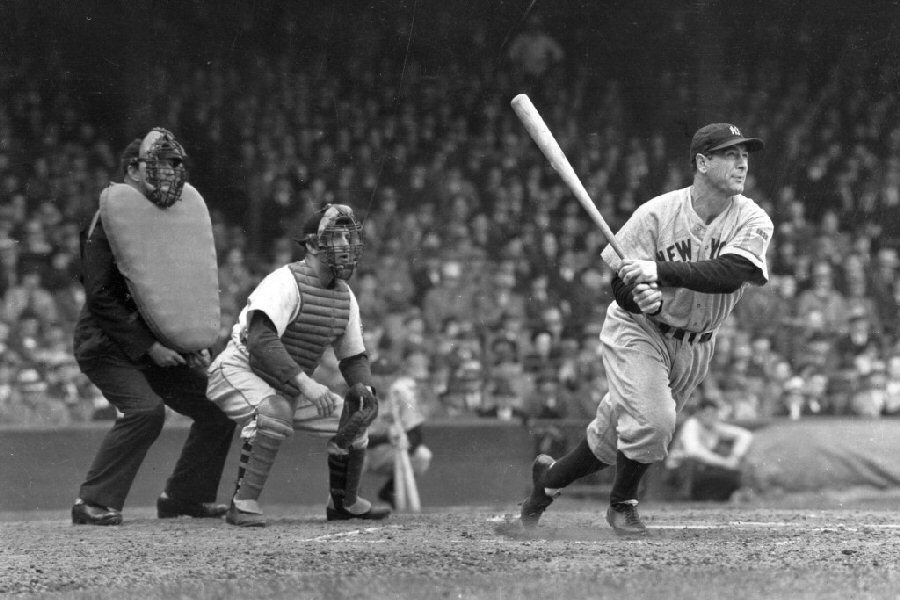
1929 -
Jimmie Foxx, A's (.350/.381/.700, 2 HR 5 RBI) - . It had taken some time, but Connie Mack had assembled his second great A's team. His first great team, twenty years previous, had been built around outstanding pitching and the famous $100,000 infield. This one was also built around outstanding pitching, but it had one of the greatest catchers of all time in Mickey Cochrane and a pair of RH sluggers, the left fielder Al Simmons and first baseman Jimmie Foxx. Also known as Double X. Or the Beast. The Beast terrified a lot of pitchers ("He has muscles in his hair" complained Lefty Gomez.) Foxx simply punished the Cubs as the A's won the first two games. But the Cubs had won the third game, and held an 8-0 lead in the seventh inning of the fourth game. They were nine outs away from tying up the series and heading home to Chicago. But Simmons led off with a homer, and suddenly the Cubs couldn't get anyone out. Four straight singles followed the Simmons homer before Burns popped out for the first out. That was followed by a single, an inside-the-park homer, a walk, a single, another single, a hit by pitch, and a two run double. Ten runs had scored - Foxx and Simmons had each had two hits and scored two runs in the outburst. And the A's wrapped it up in five games.
1930 -
George Earnshaw, A's (2-0, 0.72) - The A's were back defending their title, and they matched up with the Cardinals this time. Lefty Grove and Earnshaw won the first two games, but the Cardinals came back to beat Walberg and Grove to tie the series. In the pivotal fifth game, Earnshaw and Burleigh Grimes traded zeroes for seven innings. The A's threatened in the eighth, loading the bases with one out but Grimes escaped the jam. Earnshaw had been removed for a pinch hitter, so Grove came out of the pen and got the win when Jimmie Foxx homered in the ninth. But Earnshaw came back two days later to make his third start of the series, and put up his second complete game victory as the A's repeated as champs.
1931 -
Bill Hallahan, Cardinals (2-0, 0.49, 1 SV) - A rematch of the previous year's series saw the Cardinals turn the tables on the mighty A's. This was the series famous for Pepper Martin's performance, which was memorable indeed - Martin hit .500/.538/.792, led both teams with 5 R, 5 RBI and 5 SB, and generally drove A's catcher Mickey Cochrane out of his mind. But Hallahan's work was undeniable - he pitched a shutout in Game Two to even the series, a complete game victory in the fifth game, and he came out of the pen to get the final out of the series, facing the tying run.
1932 -
Lou Gehrig, Yankees (.529/.600/1.118, 3 HR 8 RBI) - Babe Ruth was getting old (37) and this would be his last World Series appearance. He'd make it memorable, hitting .333/.500/.733 and touching up Charlie Root for one of the most famous homers in Series history. It was his second of the game and put the Yankees ahead 5-4; Gehrig immediately followed with
his second of the game, and Root was excused for the rest of the day. Gehrig had started the Yankees scoring in each of the first two games, and he drove in three more runs in the finale as the Yankees swept the Cubs.
1933 -
Carl Hubbell, Giants (2-0, 0.00) - Walter Johnson had tried managing the Senators but despite winning at least 92 games three years in succession could never finish higher than second. So Clark Griffith fired the living legend and replaced him with his 26 year old shortstop, Joe Cronin. And it worked. It didn't hurt that Connie Mack had started selling off his stars again, and that Babe Ruth was another year older. The Sens hooked up with the Giants that October, who had been managed by first baseman Bill Terry since John McGraw's sudden retirement the previous summer. Hubbell tossed two complete game victories, the second an 11 inning effort in the finale as the Giants won in five.
1934 -
Dizzy Dean, Cardinals (2-1, 1.73) - The Gas House Gang was a one-year wonder, and Ol' Diz didn't have long at the top of the game either. But their big year was
unforgettable, even if it happened generations before we were born! After winning 30 during the season, three of them in the final
six days, to pitch the Cardinals to the pennant, Dean tossed a pair of complete game victories in the Series, the second a shutout in the seventh game. He also did a memorable turn in the fourth game as a pinch-runner - he broke up a potential double play the hard way, intercepting the relay from shortstop Rogell
with his head. His teammates carried their dazed and barely conscious ace off the field, and headlines the next day read "X-RAYS OF DEAN'S HEAD REVEAL NOTHING."
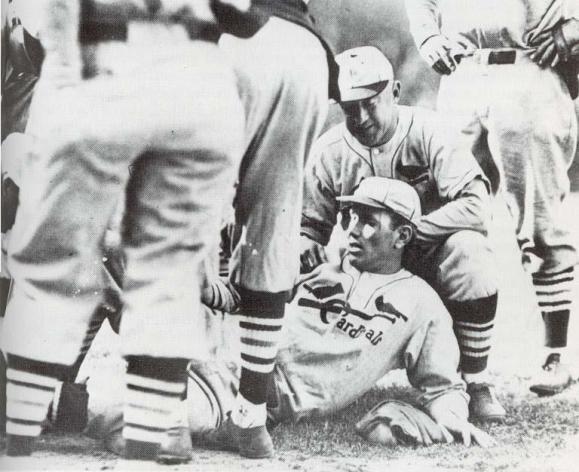
1935 -
Tommy Bridges, Tigers (2-0, 2.50) - The Tigers finally won a championship, after coming up short on four previous tries. Now the eternally hapless Browns were the only AL team never to win a title. Bridges was a slightly built curveball artist whose life took a sad turn when he came back from the war with an alcohol problem. But that was years in the future. Against the Cubs, he tossed a pair of complete game victories and pulled a nifty Houdini act in the ninth inning of the finale - with the score tied 3-3 and Stan Hack on third after leading off with a triple, Bridges got a K, a comebacker and a flyout to escape the jam and collect the win when the Tigers scored in the bottom half..
1936 -
Jake Powell, Yankees (.455/.538/.636, 1 HR 5 RBI) - The first Yankee dynasty was over. Miller Huggins was dead, Babe Ruth had retired, and the Yankees had just one pennant in the previous seven seasons. The second great dynasty begins right here. In the eight seasons from 1936 through 1943, they won seven pennants and six championships.The 1936 team might have been the best of the bunch. They were surely one of the greatest teams ever. They tore the league apart, finishing 19 games ahead of the second place Tigers. They scored 1,065 runs, just two shy of the all-time mark (which they'd set back in 1931.) They had Bill Dickey, Joe DiMaggio, Lou Gehrig, Tony Lazzeri in the lineup - all Hall of Famers. Red Rolfe and George Selkirk were merely all-stars. Cooperstown would eventually summon pitchers Lefty Gomez and Red Ruffing as well. That's a
lot of Hall of Famers and they were all pretty close to their prime. So which of these immortals stepped up to lead them to a six game victory against the Giants in the Series? None of them? It was the guy who'd come over from Washington in a mid-season deal and would spend most of his career as a fourth outfielder? Of course it was.
1937 - Lefty Gomez, Yankees (2-0, 1.50) - The Yankees were back, and this time they dismissed the Giants in five games, outscoring them 21-3 in the first three games. Only a Carl Hubbell win in the fourth game averted the sweep. They'd had basically a three man offense during the season - Gehrig, DiMaggio, and Dickey - but in the Series, everybody chipped in with the bat. Lefty Gomez allowed just three runs while pitching complete game wins in the opener and the finale.
1938 - Red Ruffing, Yankees (2-0, 1.50) - Gabby Hartnett's "Homer in the Gloamin" put the Cubs into the Series instead of the Giants. The Yankees didn't care, and don't appear to have broken much of a sweat either as they simply blew away the Cubs, outscoring them 22-9. They got offense from all over the lineup - Ruffing provided complete game wins in the opener and the clincher.
1939 - Charlie Keller, Yankees (.438/.471/1.188, 3 HR, 6 RBI) - So Cincinnati took a crack at derailing the New York juggernaut, making just their second Series appearance ever twenty years after winning a tainted title in 1919. The Yankees still didn't care, and swept them behind four different starters; Keller was involved - either scoring or driving in - more than half the runs they scored in the series. The last game went to the tenth inning tied at 4-4. With one out and Crosetti on second, Keller reached on an error by the shortstop. With runners on the corners, DiMaggio singled to right to score Crosetti, and when the right fielder bobbled the ball, Keller came home as well. He seems to have collided with Reds catcher Ernie Lombardi, as he fielded the throw from the outfield in front of the plate and then turned back and lunged at Keller charging home. The film is choppy but it does suggest contact between Keller and the upper part of Lombardi's body and head. At any rate, the ball rolled a few feet away, as Lombardi lay stunned for a moment. Meanwhile DiMaggio had been running hard from the moment he left the batter's box, and now he came flying home. Lombardi scrambled after the ball, retrieved it, and then attempted to tag DiMaggio, who executed a very nifty slide and was called safe although the Reds all protested. The score was now 7-4, and when the Reds were retired in the bottom half of the inning, the Series was over. The Reds had lost and it was all Ernie Lombardi's fault - the Series became famous for what would always be called Lombardi's Snooze.
